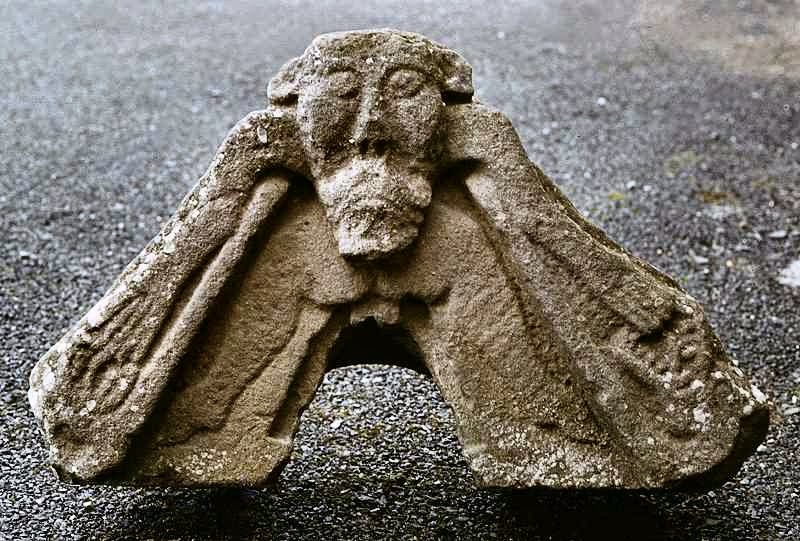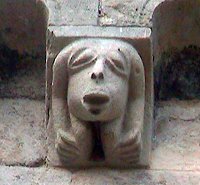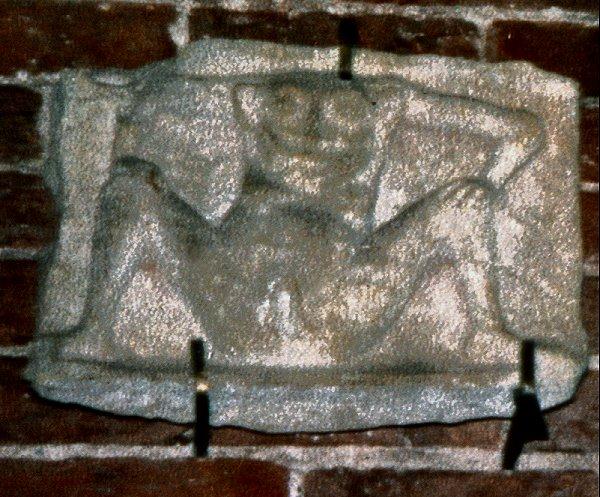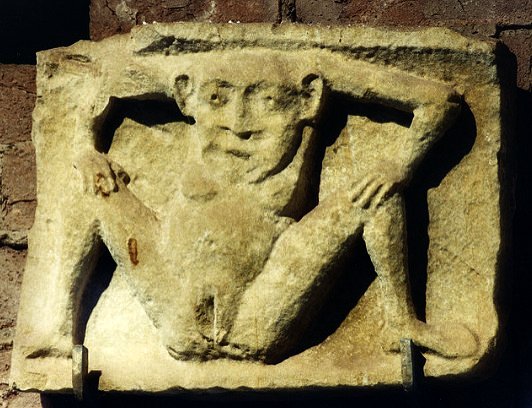Berrymount (Cavan)
While the figure at Rath was part of a
window-sill, this is a window-top (apex) and is the only surviving
stone
from Tomregan Round Tower (bell-tower and observation-post) which was part
of a destroyed monastery.
It is unclear whether the contortionist torso-less figure is male (showing
scrotum) or female (showing labia),
but is most probably the former, since the face is moustachioed and seems
to have a little beard.
The buttocks are seen as from behind, while the head - typical of late Irish
Romanesque figures - is seen frontally.
It resembles a Blemya,
but a rather more baroquely-complicated one than another enigmatic example
at Saint-Antonin-Noble-Val.
Two toothy, Hellish monsters bite the figure's hands - so it seems to be a
clerical comment
(enthusiastically carved by a good sculptor in the Norse-Irish style) on the
'goings-on' at markets, fairs and festivals.
The fair at Donnybrook near Dublin was the subject of condemnation right up
to the end of the 18th century.

Another interpretation makes this out to be a portrait of bearded, tonsured,
Saint Bricín (of Tomregan = Tuaim Bricín)
displaying his scrotum and holding a skull in one hand and a trepanning-saw
in the other.
Such interpretation is typical of believing Catholics (especially in France),
who will invent any obscure (or obscurantist) explanationrather than see the
obvious.
A simpler form of Blemya at Romsey Abbey (Hampshire).

A beard-pulling Blemya
can be seen at Saint-Antonin-Noble-Val.>
This post-Romanesque exhibitionist, badly photographed by an unknown contributor,
at Marienhafen
(Ostfriesland) Germany, is not exactly a Blemya.
The arms emerge from behind the ursine ears, and the hands rest on the knees
of its splayed legs.
It is probably one of the many post-Romanesque exhibitionists inspired
by the corbel at Saint-Vivien
in the Gironde.

Here is a much better photo of the re-mounted figure..

"On the old church of Marienhafen, in East Friesland, were numerous
animals cut in stone
which adorned the portal and extended on the frieze entirely round the building.
The edifice was demolished in 1829..." (E.P.
Evans, Animal Symbolisim in Ecclesiastical Architecture, page 235.)
The animal figures were all mediæval satires, such as beasts celebrating
Mass and performing funerals,
the wolf at school, the burial of the fox, etc.
This sheela-na-gig figure was, presumably, the (or an) exception.
More information, on another site here.
